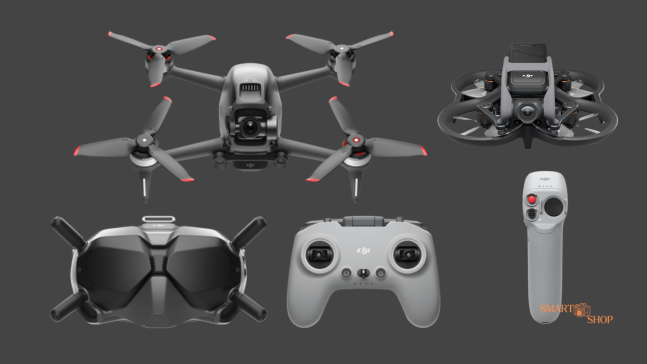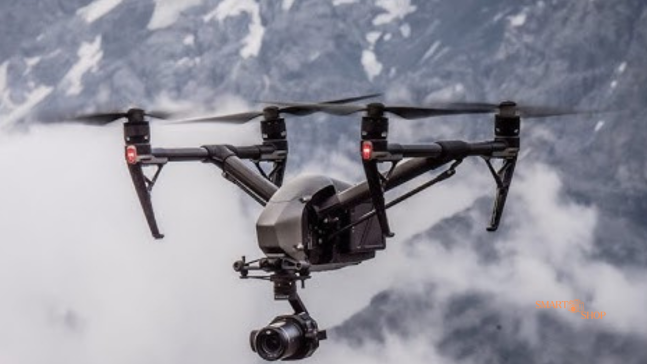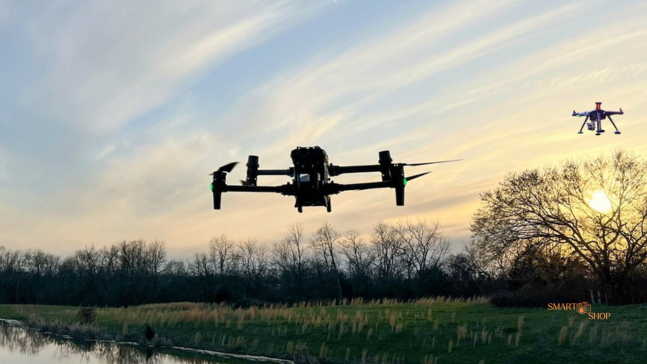FPV stands for First-Person View in the context of what does fpv mean in drones. It refers to a method used to control a drone from the pilot’s viewpoint.
First-person view (FPV) allows drone pilots to experience the flight through a camera as if on board the aircraft. This immersive perspective is achieved using a camera mounted on the front of the drone, which streams live video to glasses, headsets, or the screen of a mobile device.
FPV is a popular technology among hobbyists, gamers, and professionals, offering a unique and engaging way to pilot drones. It facilitates precise manoeuvres in drone racing, provides a real-time view for photography and aerial inspections, and enhances the overall flying experience. This technology has revolutionised drone applications, allowing for more dynamic and intuitive control than traditional line-of-sight flight.
The Thrill Of Fpv Flight
The Thrill of FPV Flight provides an immersive experience that transforms drone piloting. Pilots see through the eyes of the drone, fly high, and navigate the sky with a bird’s-eye perspective. It’s an adrenaline-filled ride that feels like entering a new realm: in the cockpit of a small plane, soaring to new heights.
Defining Fpv In The Drone World
FPV stands for First-Person View, a method of controlling a drone from the pilot’s point of view. The pilot uses a special camera mounted on the drone, which transmits live video to glasses or a screen. Imagine piloting as if you were sitting right in front of your drone!
The Sensory Experience Of First-person View
The FPV sensory experience captures the essence of flight. With FPV goggles, pilots feel like they are flying. Every twist and dip, experienced in real-time, gets the heart racing. This table shows the components:
| Component | Function |
| FPV Camera | Streams live video from the drone |
| Transmitter | Sends video to the pilot |
| FPV Goggles/Screen | Displays video for immersive experience |
Imagine watching a movie where you are the leading actor, flying between obstacles and exploring landscapes. In a nutshell, that’s FPV flying, but you control the story. It’s not just about the view. It’s about feeling the flight, the wind, and the excitement of high-speed manoeuvres.
Diving Into Fpv Drone Technology
Imagine taking to the sky and seeing what the drone sees, as if you were sitting in the cockpit. This is not a video game; It is FPV (First Person View) drone technology. FPV gives you an immersive experience, making flying a drone exciting and intuitive. Let’s explore the nuts and bolts of FPV systems and how they send clear, live video from the sky to your goggles or screen
Components Of An Fpv System
Every FPV setup consists of several vital components that work in harmony. These include the FPV camera, which captures live images; the transmitter, which sends videos to the pilot; and the receiver. Pilots watch the broadcast on FPV goggles or monitors.
- FPV camera: capture video in real-time
- Transmitter (TX): sends video to the pilot.
- Receiver (RX): receives the transmitted video
- FPV Goggles/Monitor: show video
- Antennas: improve signal quality
- Battery: powers the system
Transmission Of Video Signals
How do the images from the FPV camera reach the pilot’s eyes? Through a stream of video signals transmitted over the air. The transmitter sends these signals at various frequencies and power levels. Higher frequencies or stronger signals can mean more explicit video or longer ranges. The receiver then captures these signals and displays the live stream
| Component | Function | Importance |
| Transmitter | Sends video signals | Facilitates live feed |
| Receiver | Captures signals | Ensures video is received |
| Antennas | Boosts signal | Enhances quality and range |
Different configurations may require different frequencies. A balance between latency, range, and clarity is crucial. Deciding on the right equipment can make all the difference in FPV flight.
Types Of Fpv Drones
FPV drones revolutionise the way we experience flight. By using FPV goggles, pilots see what the drone sees. This characteristic defines several types of drones. Whether racing or exploring, FPV technology offers an immersive experience. Let’s explore the different types of FPV drones that are available
Racing Drones Harnessing Fpv
Racing drones are all about speed and agility. Pilots navigate complex courses at high speeds. These drones are lightweight and optimised for performance. These are the key features to look for in racing drones:
- Lightweight Frames: Minimises resistance and allows for tight turns.
- Powerful Engines: Provides the thrust needed for rapid acceleration.
- Responsive Controls – Ensures precise movements and quick reactions.
- Advanced FPV Cameras: Delivers clarity and low latency video for pilots
Exploratory Drones With First-person View
Exploratory drones focus on stability and camera quality. They allow pilots to discover landscapes from a bird’s eye view. Pilots experience exploration like never before. Exploratory drones usually present
| Feature | Description |
| High-Def Cameras | Captures stunning detail from above. |
| Gimbals | Stabilises shots for clear images, even in motion. |
| GPS Integration | Enables smooth navigation and steady hovering. |
| Longer Flight Times | Allows for extensive exploration without frequent landings. |
The Pilot’s Perspective
The pilot’s perspective on drone flight transforms how we see and explore the world. When pilots switch to first-person view, or FPV, they’re not just flying drones. They embark on an exciting journey from a bird’s eye view. Imagine running through the sky like a drone; that’s FPV for pilots.
Navigating With Fpv
FPV navigation is like entering a video game but is real life. Pilots use a camera mounted on the drone to stream live video. This video appears on the pilot’s monitor, glasses, or headphones. Here’s a breakdown of how it works:
- The drone’s camera captures high-quality videos in real time.
- Live images are transmitted directly to the pilot’s goggles or screen.
- Pilots manoeuvre under challenging places by seeing precisely what the drone sees.
With FPV, pilots navigate with greater precision. Avoid obstacles easily and fly precisely in races or while capturing impressive images.
Challenges And Excitement For Pilots
Flying FPV is exciting, but it comes with its challenges. Pilots face a steep learning curve when they start. Here are some of the challenges they face:
- Maintain orientation during complex manoeuvres.
- Deal with signal interference and video quality issues.
- Master the controls to fly with fluidity and precision.
Despite these challenges, the excitement is incomparable. Pilot experience:
- Race at high speeds through courses with sharp turns and obstacles.
- Performing aerial acrobatics that test your skills and reflexes.
- The pleasure of exploring and capturing stunning views from above.
Daring manoeuvres and precision flight define the adrenaline-filled world of FPV drone piloting. Pilots enjoy an immersive experience like no other.
Getting Started With Fpv
FPV stands for First Person View. It refers to a method used to control a drone from the pilot’s point of view. The pilot sees what the drone sees. This immersive experience comes from a camera mounted on the drone, which sends live video to glasses or a screen. It’s like you’re flying in the cockpit. Ready to join the FPV world? Here’s how to start your high-flying adventure.
Choosing Your First Fpv Drone
For beginners, choosing a suitable drone is essential. Focus on these factors:
- Size: A smaller drone is usually better for learning.
- Repairability: You will crash. Choose a drone that you can fix.
- Price: Start with something affordable.
The most important thing is to opt for a labelled ready-to-fly drone (RTF). This means it is pre-assembled and includes everything you need to get started.
Essential Gear For Fpv Flying
Equipping yourself with the right equipment ensures an exciting and safe FPV experience. Essential items include:
| Gear Type | Details | Why You Need It |
| FPV Goggles | Device worn on eyes | Sends live video from drone |
| Transmitter | Hand-held remote | Controls the drone |
| Batteries | Rechargeable power source | Powers your flights |
Get started with this gear to excel in FPV flying. Give yourself time to learn the controls. Practice frequently and always fly safely. Your FPV journey has no limits.

Legal And Safety Considerations
Legal and safety considerations are paramount when flying with FPV (first-person view) drones. Understanding regulations and practising safety protocols ensures the enjoyment of FPV flights and the protection of the environment and its inhabitants. It is essential to fly responsibly, respecting the laws designed to maintain airspace safety.
Governing bodies around the world have established rules for FPV drone operations. The Federal Aviation Administration (FAA) dictates specific regulations that FPV pilots must follow in the United States. These include:
- FAA registration of the drone if it weighs more than 0.55 pounds (250 grams).
- Compliance with the Part 107 rule for commercial pilots, which may require passing an aeronautical knowledge test.
- Compliance with FAA Remote ID rules.
- Do not fly above 400 feet in uncontrolled airspace (Class G), and obtain authorization in controlled airspace.
- Maintain a visual line of sight (VLOS) or have a spotter do so.
Local laws may impose additional restrictions on where and how FPV drones can be operated, such as in parks or near airports. Pilots should periodically check for updates to remain compliant.
To ensure safety during FPV drone flights, pilots should adopt the following best practices:
- Pre-flight checks: Verify that the drone is in optimal condition for flight.
- Adopt a buddy system: Have a spotter to maintain VLOS and alert about hazards.
- Stay informed about local weather conditions to avoid flying in adverse weather conditions.
- Use a fail-safe mechanism, such as return to home (RTH), in case of signal loss.
- Respect privacy: Avoid flying over private property without permission.
FPV pilots can confidently take to the skies by following these steps, knowing they prioritise safety and legality in their exciting aerial adventures.
Fpv Drone Racing: A Competitive Landscape
FPV (first-person view) drone racing turns the sky into a high-speed circuit. Runners wear headsets that show live video from their drones. This modern sport excites and excites.
The Rise Of Drone Racing Leagues
Drone racing leagues have skyrocketed in popularity. They transform pilots into athletes. Significant cities host these high-octane events. Local groups with international competitions connect pilots from all over the world. Leagues set rules and standards. They guarantee fair and exciting racing.
- Drone Champions League (DCL)
- MultiGP Drone Racing League
- International Drone Racing Association (IDRA
Training For Fpv Drone Races
To compete, drivers must hone their skills. Simulators and practice runs are crucial. Pilots learn to manoeuvre in confined spaces. Quick reflexes and mastery of control are essential. It’s not just about the drone but also the pilot’s precision.
| Training Method | Benefits |
| Simulators | Safe, cost-effective, diverse scenarios |
| Practice Races | Real-world experience, pressure handling |
Innovations And Future Of Fpv Drones
FPV, or first-person view, drones take flight to exciting new heights, combining the thrill of piloting with immersive visuals. As technology advances, the future of FPV drones shines with possibilities. Experts predict that the advances will reshape not only recreational flying but also industries in general. This section explores the innovative technology transforming FPV drones and what we could expect next.
Emerging Technologies In Fpv
- Improved autonomy: New algorithms allow drones to fly alone, making complex manoeuvres look easy.
- Superior Connectivity: Improved communication systems such as 5G ensure smooth and lag-free transmission of drone images.
- Better battery life: Advances in energy storage lead to longer flights, freeing drones from time constraints.
- AI and machine learning: Smart drones learn from every flight and make smarter navigation decisions.
FPV drones become more intuitive, durable, and connected with each technological advancement. These creations promise to unlock new applications, from delivering goods to enhancing virtual reality experiences.
Predicting The Next Big Thing In Fpv Flight
| Technology | Impact on FPV | Expected Breakthrough |
| AI Copilots | These digital assistants offer real-time tips, improving flight safety and skill. | Soon, AI could fully navigate, with pilots enjoying the ride. |
| Wearable Controls | Control drones with movements, no bulky remote needed. | Look out for glove-like devices that bring a natural feel to flying. |
| 360° Cameras | Drones equipped with these capture everything, no blind spots. | Expect bird’s-eye views to become even more breathtaking. |
Knowing the next big thing in FPV isn’t easy, but trends point to a combination of immersion and autonomy. Imagine drones that fly farther faster while remaining under precise control, offering pilots a limitless sky to explore
Frequently Asked Questions On What Does Fpv Mean In Drones
What Is Fpv On A Drone?
FPV stands for First Person View on a Drone, which allows pilots to see what the drone sees in real-time through a camera, glasses, or monitor.
How Does Fpv Enhance Drone Flying?
FPV provides drone pilots with an immersive flight experience, better control, and precision by allowing them to view aerial scenes from the drone’s perspective.
Can Beginners Use Fpv Drones?
Yes, beginners can use FPV drones, but it is advisable to practise on simulators or with basic models before flying more advanced and faster drones.
What Equipment Is Needed For Fpv Flying?
FPV flight requires a drone with a built-in camera, video transmitter, FPV goggles or monitor, and sometimes a separate remote control.
Are Fpv Drones Used In Drone Racing?
FPV drones are the primary type used in drone racing because they offer the pilot precise control and real-time view, which is essential for competitive racing.
Conclusion
Exploring the exciting field of FPV in drones reveals a technological revolution. As pilots take to the sky, they experience flight through the eyes of the drone, transforming remote-controlled aviation. It’s clear that FPV is not just a feature; it is a gateway to immersive aerial adventures, promising innovation and inspiration for enthusiasts worldwide.
Embrace FPV; The sky’s the limit.




Pingback: Can You Use a Drone to Recover Deer